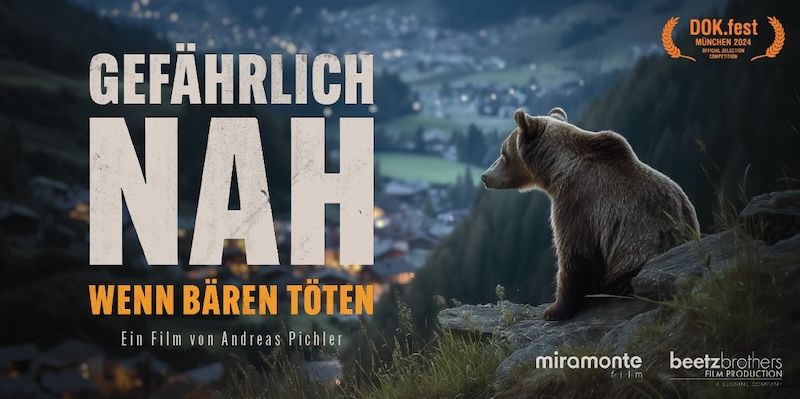OrsaJj4 with puppy. Source Lav.it
The South Tyrolean director Andreas Pichler analyzes in a documentary the difficult relationship of coexistence between man and the plantigrade
The death of Andrea Papi two years ago brought the bear reintroduction project into Trentino back to the attention and center of the debate. Now the South Tyrolean director Andreas Pichler has analyzed it in a documentary filmthe complicated relationship between man and plantigrades.
The film is available from May 2nd in German on Sky Germany with the title “Gefährlich nah – Wenn Bären töten” (Dangerously close, when bears killed.), while this summer it will arrive in Italy on the big screen and then in autumn on Rai3.
Pichler retraces the stages of the Life Ursus repopulation project and visits the Trentino valleys, giving voice to inhabitants and animal rights activists, as well as foresters and experts. The director also interviews Andrea Papi’s parents. There is also a look at Bavaria, where the debate broke out last year.
The documentary asks itself: Who does nature belong to, man or animals? For three years Pichler has been dealing with the issue of Trentino bears, often accompanying foresters into the woods. In fact, he began his work long before the Caldes tragedy, interviewing those who are in favor of the presence of bears and those who would like to limit their number.
“The death of Andrea Papi changed everything – underlines documentary maker Pichler in an interview with RedaktionsNetzwerk Deutschland (RND). “In Val di Sole, in the autonomous province of Trentino, where the fatal bear attack occurred, and also in the nearby valleys, the local population is scared and no one dares to go into the woods anymore. There have been demonstrations against the presence of bears. The runner’s death was a trauma for many locals.” adds Pichler.
Brief account of what happened
Andrea Papi. Source facebook
Andrea Papi, 26, from Caldes, was jogging in the woods above his village in the late afternoon of 6 April 2022 when he was attacked. His body, found that same evening, bore signs that left no doubt: a bear had killed him. However, since bears are not normally aggressive towards humans, it was reasonable to assume that Andrea had come across a mother bear, who had attacked him to protect her cubs, presumably seeing them as threatened. Hypothesis which later turned out to be correct. With the help of DNA traces, it was possible to determine the identity of the bear relatively quickly: it was JJ4. Two weeks after the fatal attack, the bear and two of her three cubs were captured alive, with a trap (the third cub was sitting next to the trap when the rangers arrived). The mother bear was taken to the outdoor enclosure of Casteller, in Trentino, and her three cubs were immediately released.
JJ4 is still locked up in the Casteller Wildlife Center in Trento, after an administrative court canceled the killing order issued by the Province of Trentino.
“Gefährlich nah – Wenn Bären Doku” (“Dangerously Close – When bears become a documentary”)
The runner’s death also changed many things for Andreas Pichler: when the tragedy occurred, in fact, the director had already been filming the documentary “Dangerously close – When bear kill” for over a year. However, his attention was not on the then little-known JJ4, but on the M49, called Papillon. The young male bear hit the headlines in Trentino in 2019 because he had been captured twice and on both occasions he had escaped. Previously, Papillon had killed numerous animals and had also entered the mountain pastures. Even then people had been afraid. “My film project was focused on M49 and, after Andrea Papi’s death, we threw away everything we had filmed about this bear,” Pichler explains to RND.
With JJ4, there was now a new prominent main character for the film, a new drama to tell, an extreme escalation of the conflict generated around the reintroduction of the bears, which was ultimately nothing new: “I have followed the ‘Life Ursus’ project in the Adamello-Brenta National Park (also financed by the EU), born 25 years ago, from the beginning, and I thought for a long time that one day a film should be made about this,” underlines Pichler, who lives in Bolzano and is winner of the Grimme Award. “Ultimately, the reintroduction project leads back to the question of who is the real owner of the mountains and nature and what is the relationship that we humans have with nature”. Great questions.
In the film, which also contains breathtaking nature footage, Pichler traces the beginnings of the “Life Ursus” project, tells the story of the reintroduction of bears from Slovenia and the often irreconcilable and ideological war between the local population and animal rights activists, even before the runner’s death. Pichler allows all the people involved to have their say: the parents of the killed runner, the local farmers, the animal rights activists, but above all the Forestry Corps guards and the veterinarians who look after the bears who, with the death of Papi they are “between a rock and a hard place”, as the head of the forest rangers Claudio Groff says in the film. Locals believe the rangers do not provide sufficient protection, while animal rights activists consider them “bear killers”.

The war against bears is the result of a failed policy
For Pichler, the bitter war against bears is the reflection of an extremely polarized society, in which problems are exploited in a populist way and in which agreeing on pragmatic solutions has become practically impossible.
For Pichler, recognizing the right to life of individual animals, as requested by animal rights activists, is an attitude that deserves respect. However, the director also shows understanding for the local population, “who was never asked if she agreed with the reintroduction of bears”. In the countryside, underlines the South Tyrolean Pichler, the forest begins right next to the village. “And if you are afraid of going into the woods, you feel like you can no longer move freely and are therefore deprived of your rights“. Removing the problem animals would probably have been the only way to avoid fatal accidents and ensure that the presence of bears was accepted by the local population.
For Pichler, the escalation of conflict between the local population and animal rights activists is also the result of a political failure. Since the reintroduction of the bear began, the Trentino authorities have not informed the population about the potential dangers linked to the bear and have not developed behavioral rules in case of close encounters with the bear.
“The risk has been downplayed for years,” underlines the director. In the film, retired veterinarian Alessandro De Guelmi also points out that the risk can be massively reduced by following a few rules: “For example, if you slowly walk away from a bear that suddenly appears instead of running away in panic and screaming, there is a 90% chance that nothing will happen.” The film mainly deals with people’s fears.
According to Pichler, the failure of the policy and the extreme polarization between opponents and supporters of the bears have led “everyone loses: the local population, animal rights activists, rangers and the bears themselves”.
In the beginning there was still one “basic acceptance” of the reintroduction project among the Trentino population, but this was lost with the death of Papi- “I fear, forever”.
However, a successful and permanent reintroduction of bears is only possible if supported by the local population. What happens when this doesn’t happen can be seen in Trentino: last year several dead bears were found, probably killed illegally.
Andreas Pichler’s film is about bears, but even more about people and their fears. “The death”says Roberto Guadagnini, chief veterinarian of the rangers’ bear team, “It’s always a tragedy. But if the death is caused by a wild animal, it is not acceptable in our society.”
Because such a death reminds us humans “that we are weak”. The bear is ten times stronger than man. And this has consequences: “As a human species, we must ask ourselves what kind of nature we want: An artificial nature à la Walt Disney – or a nature with forests where life still exists that we do not have under our control”. In the forest you can also be bitten by an infected tick and die of meningitis, Guadagnini points out. The problem with bears is therefore not their potential danger as such. “The problem is that we have to accept the danger. If we do not accept bears living with us in our mountains, we are not simply rejecting bears. We are rejecting nature as such.”








